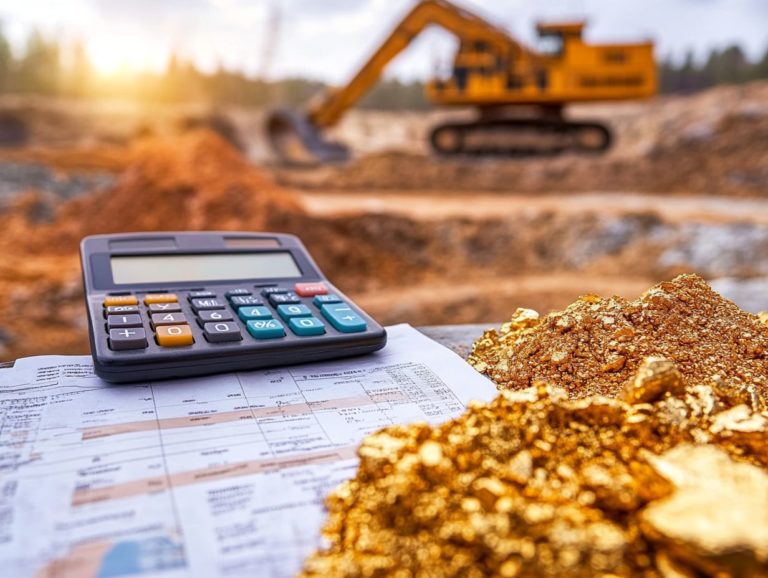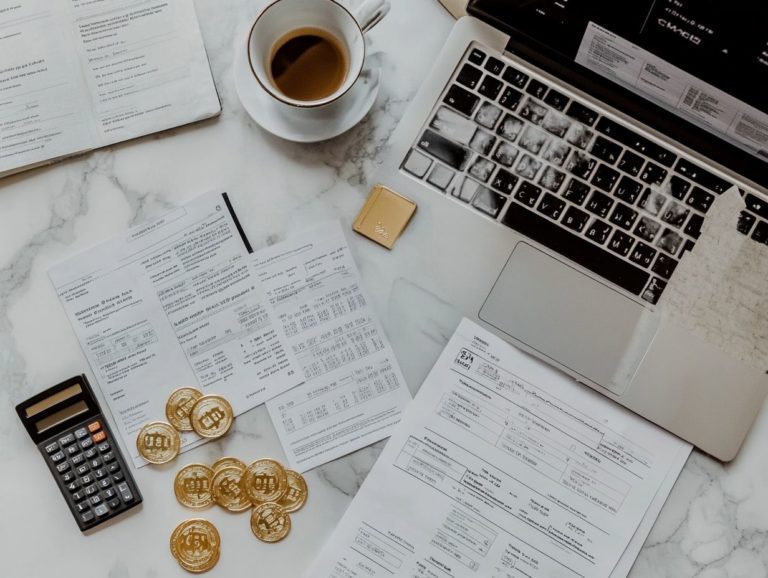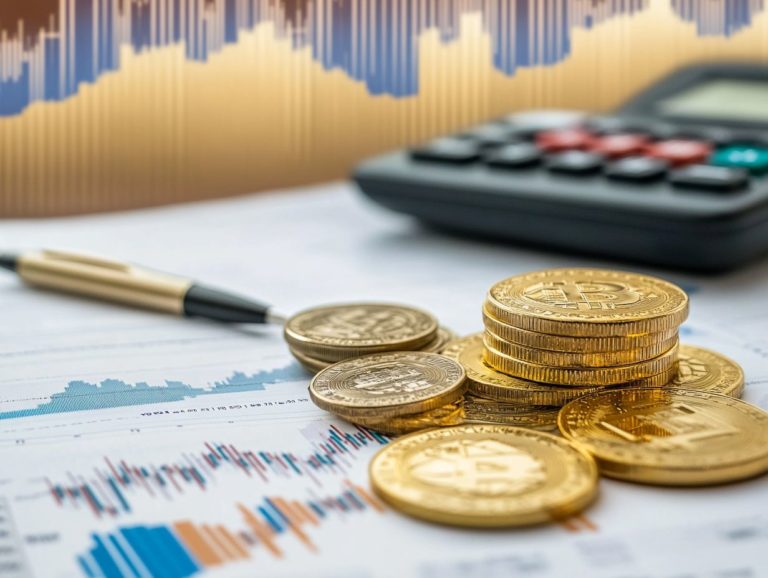Tax Considerations for Precious Metals in Your Portfolio
Investing in precious metals can be a lucrative addition to your portfolio, providing both stability and the potential for growth.
Navigating the tax landscape surrounding these investments is crucial for maximizing your returns. This article delves into the relationship between precious metals and tax implications, including capital gains taxes and reporting requirements.
Uncover strategies to minimize your tax burden, explore unique considerations for various metals like gold and silver, and discover the advantages of consulting a tax professional.
Prepare to refine your investment strategy!
Contents
- Key Takeaways:
- Why Precious Metals Are Essential in Your Investment Portfolio
- Tax Implications of Investing in Precious Metals
- Ways to Minimize Taxes on Precious Metal Investments
- Tax Considerations for Different Types of Precious Metals
- Tax Planning for Precious Metal Investments
- Frequently Asked Questions
- What are the tax considerations for holding precious metals in my portfolio?
- Are there any tax benefits to investing in precious metals?
- How are capital gains taxes calculated for precious metals?
- Are there any ways to minimize taxes when investing in precious metals?
- Do I have to pay taxes on precious metals if I hold them in a storage facility?
- Are there any tax considerations to keep in mind when gifting precious metals?
Key Takeaways:
- Precious metals can be a valuable addition to an investment portfolio, but it’s important to understand the potential tax implications before investing.
- Capital gains tax and reporting requirements are key considerations for investing in precious metals.
- Strategies for minimizing taxes on these investments include planning with a tax professional and utilizing tax-advantaged accounts.
Why Precious Metals Are Essential in Your Investment Portfolio
Understanding precious metals as an essential part of your investment portfolio involves exploring how these assets, including physical gold and silver, enhance your financial growth and diversify your investments.
Explore effective strategies now, such as precious metals IRAs and gold mining stocks, to safeguard your wealth against market fluctuations and economic uncertainty, while being aware of the unique regulations governing these investments.
The historical context showcases the resilience of precious metals during crises. Their potential for long-term gains makes them an appealing choice for optimizing your portfolio.
Overview of Precious Metals as an Investment
Precious metals, including physical gold and silver, have long been esteemed as valuable investment opportunities, offering stability and diversification during turbulent economic times. Their allure lies in both their rarity and intrinsic value, cherished by civilizations throughout history.
You may find yourself turning to these assets as a hedge against inflation and economic downturns, especially when traditional markets show signs of volatility. With the growing demand for gold in industries such as technology and jewelry, current market trends indicate heightened interest, particularly in the face of geopolitical tensions.
Historical gold prices often serve as a reliable compass, guiding your investment decisions as you find the right balance between risk and reward in uncertain climates. This intricate relationship between precious metals and market dynamics continues to evolve, capturing the attention of discerning investors like yourself.
Tax Implications of Investing in Precious Metals
Investing in precious metals comes with specific tax implications that can significantly impact your overall tax liability. It’s essential for you to grasp the nuances of capital gains tax, especially the distinctions between short-term and long-term gains, if you’re considering venturing into precious metals investments.
Navigating IRS regulations including the collectibles tax rate and the reporting requirements under forms like Form 1099-B is crucial to avoid any unexpected financial repercussions. With the tax year 2023 on the horizon, staying informed about how these rules apply to your investments and exploring strategies to mitigate your tax burden is essential.
Capital Gains Tax on Precious Metals
Capital gains tax is a crucial factor to consider when investing in precious metals, as it directly affects the profitability of your investments based on whether your gains are classified as short-term or long-term.
Understanding these tax implications is vital for developing effective investment strategies, especially given the differences in rates. Typically, short-term capital gains applied to assets held for one year or less are taxed at ordinary income rates, which can be significantly higher than those for long-term capital gains.
For example, if you sell gold bullion after just six months, you could be facing tax rates as high as 37%. However, holding it for over a year may allow you to benefit from reduced rates of 15% or 20%, depending on your overall income. Such potential variations often play a key role in your decisions about when to buy and sell, encouraging you to adopt strategies that maximize your after-tax returns. To navigate these complexities, it’s important to understand the tax effects of precious metals trading.
Now, consider consulting a tax professional to refine your strategy further and make informed decisions.
Reporting Requirements for Precious Metals
Understanding the reporting requirements for precious metals investments is crucial for ensuring compliance with IRS regulations. This is especially important for accurately filing forms like Form 1099-B.
You should also familiarize yourself with the intricacies of reporting gains from both bullion and numismatic coins. Each investment type comes with its own set of IRS guidelines, highlighting the necessity of documenting every transaction with precision. Additionally, it’s important to understand tax regulations for precious metals in retirement accounts.
This means keeping hold of purchase receipts, invoices, and any relevant correspondence. Detailed records make your tax filings easier. By maintaining thorough documentation, you not only bolster your financial standing but also reduce the risk of facing penalties during audits.
Being organized in this area is essential for navigating the complexities of taxation on precious metals. Utilizing tax planning for precious metals in your portfolio ultimately leads to a more seamless investment experience.
Ways to Minimize Taxes on Precious Metal Investments
Minimizing taxes on your precious metal investments is an essential component of managing your money wisely. You can employ a variety of strategies to achieve this. One effective method is to take advantage of tax-advantaged accounts, like a precious metals IRA.
This approach not only helps protect your investments but also enhances your overall financial strategy.
Strategies for Reducing Capital Gains Tax
Implementing effective strategies to reduce capital gains tax demands a comprehensive understanding of IRS regulations. It’s important to know how capital losses can offset taxable gains in precious metals investments.
Consider selling assets at a loss to reduce your overall taxes. This technique can effectively counterbalance your capital gains. Being mindful of holding periods is crucial as well. Typically, assets held for over a year benefit from a lower long-term capital gains rate, which is the tax rate applied to profits from assets held longer than a year.
By proactively planning your investment timeline and regularly evaluating your portfolio performance, you can navigate the complexities of tax implications with greater ease. This ultimately enhances your overall returns. Utilizing these strategies not only improves your financial outcomes but also promotes well-considered choices, empowering you in your investment journey.
Considerations for Tax-Advantaged Accounts
Unlock amazing tax benefits with tax-advantaged accounts! Utilizing accounts like a precious metals IRA can offer significant advantages as you look to diversify your portfolio with physical gold and silver.
These accounts allow you to contribute funds that are either tax-deductible or grow tax-free, depending on the account type. For instance, with a Traditional IRA, you can make pre-tax contributions, deferring taxes on your earnings until you withdraw, maximizing your investment potential.
Conversely, a Roth IRA provides tax-free growth, enabling you to withdraw your earnings without any tax implications in retirement. Incorporating precious metals into these retirement vehicles not only enhances your portfolio’s stability but also serves as a hedge against inflation.
This makes these investment strategies tax-efficient and a savvy choice for long-term wealth preservation.
Tax Considerations for Different Types of Precious Metals
Tax considerations can vary significantly depending on the type of precious metal you choose to invest in, whether it s gold, silver, platinum, or palladium. It s crucial for you to grasp the unique implications tied to each metal to make informed investment decisions.
Gold, Silver, Platinum, and Palladium
Gold, silver, platinum, and palladium each represent valuable investment opportunities, but they come with distinct tax implications you need to consider.
Understanding these nuances can significantly shape your investment strategy. Especially when you’re aiming to optimize returns while minimizing tax liabilities.
Gold, often regarded as a safe haven asset, tends to maintain high market values due to its intrinsic qualities and historical significance. Silver, with its unique position straddling both investment and industrial uses, offers intriguing opportunities amidst its market fluctuations.
Platinum and palladium are gaining traction for their applications in technology and the automotive sector. This makes them appealing options for diversifying your portfolio.
Each of these metals invites discerning investors like you to carefully evaluate their potential benefits in light of the varying tax treatments. Understanding the effect of tax policy on precious metals investment strategies will undoubtedly influence your investment strategy and overall asset allocation.
Tax Planning for Precious Metal Investments
Effective tax planning for your precious metal investments is crucial for optimizing returns while minimizing tax liabilities. This makes effective tax planning central for both individual and institutional investors.
Working with a Tax Professional
Collaborating with a tax professional can greatly enhance your ability to navigate the detailed tax planning methods surrounding precious metal investments. These experts possess in-depth knowledge of IRS regulations.
They can guide you away from common pitfalls that could lead to costly mistakes or audits. With their expertise, you can access personalized wealth management strategies that align seamlessly with your financial goals, ensuring optimized tax outcomes.
For example, a tax professional can pinpoint specific deductions related to precious metals that you might easily overlook, maximizing your potential returns. In case of an audit, having a knowledgeable partner by your side can provide essential audit protection.
This grants you peace of mind that your financial interests are well safeguarded throughout a taxing process.
Description: This video explains the basics of investing in precious metals and the tax implications involved.
Frequently Asked Questions
What are the tax considerations for holding precious metals in my portfolio?
The tax considerations for precious metals in your portfolio will depend on how you choose to invest in them. Owning physical gold or silver may incur capital gains taxes when you sell, while investing in precious metals through a retirement account may offer tax advantages.
Are there any tax benefits to investing in precious metals?
Yes, depending on how you invest. Holding precious metals in a retirement account, such as a Gold IRA, may offer tax advantages such as tax-deferred growth or tax-free withdrawals.
How are capital gains taxes calculated for precious metals?
Capital gains taxes for precious metals are calculated based on the difference between the purchase price and the sale price of the metal. The specific rate will depend on your income level and how long you’ve held the metal before selling.
Are there any ways to minimize taxes when investing in precious metals?
Yes, a few strategies can help minimize taxes when investing in precious metals. One option is to hold the metals in a tax-advantaged retirement account.
Another option is to use tax-loss harvesting, where you sell losing investments to offset any gains from your precious metal investments.
Do I have to pay taxes on precious metals if I hold them in a storage facility?
Yes, even if you are not physically holding the precious metals, you may still be subject to taxes on any gains when you sell. It’s important to consult with a tax professional to understand the tax implications of storing precious metals in a facility.
Are there any tax considerations to keep in mind when gifting precious metals?
Yes, gifting precious metals may have tax implications for both the giver and the recipient. Any gains from the sale of the gifted metal may be subject to taxes, and there may also be gift tax implications depending on the value of the metals.
It’s important to consult with a tax professional for specific advice.
Explore the unique benefits of investing in precious metals today!
For personalized advice, consider reaching out to a tax professional who can guide you through your investment journey.













